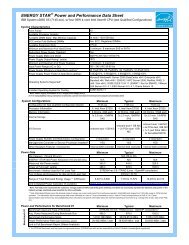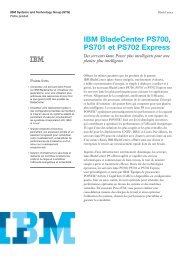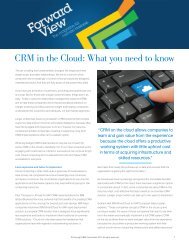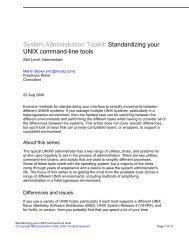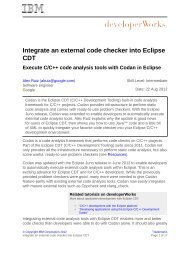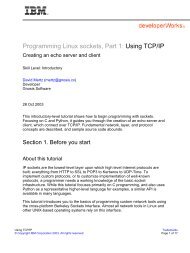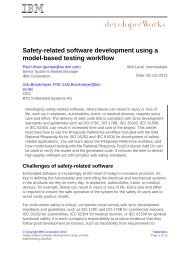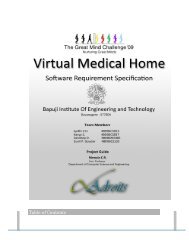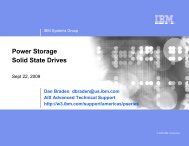Download the report to assess your city - IBM
Download the report to assess your city - IBM
Download the report to assess your city - IBM
Create successful ePaper yourself
Turn your PDF publications into a flip-book with our unique Google optimized e-Paper software.
<strong>IBM</strong> Global Business Services<br />
Executive Report<br />
Government<br />
<strong>IBM</strong> Institute for Business Value<br />
How Smart is <strong>your</strong> <strong>city</strong><br />
Helping cities measure progress
<strong>IBM</strong> Institute for Business Value<br />
<strong>IBM</strong> Global Business Services, through <strong>the</strong> <strong>IBM</strong> Institute for Business Value, develops<br />
fact-based strategic insights for senior executives around critical public and private<br />
sec<strong>to</strong>r issues. This executive brief is based on an in-depth study by <strong>the</strong> Institute’s<br />
research team. It is part of an ongoing commitment by <strong>IBM</strong> Global Business Services <strong>to</strong><br />
provide analysis and viewpoints that help companies realize business value. You may<br />
contact <strong>the</strong> authors or send an e-mail <strong>to</strong> iibv@us.ibm.com for more information.
Introduction<br />
By Susanne Dirks, Mary Keeling and Jacob Dencik<br />
The performance of core systems of <strong>to</strong>day’s cities is<br />
fundamental <strong>to</strong> social and economic progress. Faced with major challenges, <strong>the</strong>se<br />
systems can be improved and optimized through <strong>the</strong> application of smart solutions.<br />
In this second perspective by <strong>the</strong> <strong>IBM</strong> Institute for Business Value on creating smarter<br />
cities, we show how cities can <strong>assess</strong> and moni<strong>to</strong>r progress in optimizing core systems<br />
against a limited set of key parameters, as well as determine how <strong>the</strong>y measure up <strong>to</strong><br />
<strong>the</strong>ir peers. 1<br />
Today’s cities, home <strong>to</strong> more than half <strong>the</strong> world’s population,<br />
can be seen as complex networks of components: citizens,<br />
businesses, transport, communications, water, energy, <strong>city</strong><br />
services and o<strong>the</strong>r systems. Citizens and businesses rely on<br />
infrastructure systems for <strong>the</strong>ir activities and well-being.<br />
Improvements – or disruptions – in transportation, communications<br />
and utility systems can have dramatic impact on <strong>the</strong><br />
daily activities of citizens and businesses. City services<br />
integrate and coordinate <strong>the</strong> activities taking place in <strong>the</strong> o<strong>the</strong>r<br />
components. Understanding how cities improve and change<br />
through <strong>the</strong> lens of <strong>the</strong>se elements offers cities new perspectives<br />
on <strong>the</strong> progress <strong>the</strong>y are making <strong>to</strong>ward achieving<br />
strategies and objectives.<br />
As <strong>the</strong> world becomes increasingly instrumented, interconnected<br />
and intelligent in nature, cities have <strong>the</strong> chance <strong>to</strong> accelerate<br />
<strong>the</strong>ir journey <strong>to</strong>wards sustainable prosperity by making use of<br />
new “smart” solutions and management practices.<br />
Instrumentation enables cities <strong>to</strong> ga<strong>the</strong>r more high-quality<br />
data in a timely fashion than ever before. For example, utility<br />
meters and sensors that moni<strong>to</strong>r <strong>the</strong> capa<strong>city</strong> of <strong>the</strong> power<br />
generation network can be used <strong>to</strong> continually ga<strong>the</strong>r data on<br />
supply and demand of electri<strong>city</strong>. 2 The pervasiveness and low<br />
cost of existing devices and sensors, like gas, electri<strong>city</strong> and<br />
water meters, offer <strong>the</strong> ability <strong>to</strong> measure, sense and understand<br />
<strong>the</strong> exact condition of virtually anything. Add <strong>to</strong> that new<br />
sensors and devices that offer fur<strong>the</strong>r data ga<strong>the</strong>ring possibilities,<br />
such as RFID tags (more than 33 billion RFID tags will be<br />
active by 2010 – five for every inhabitant of <strong>the</strong> planet, see<br />
Figure 1). 3 These existing and new sensors and devices can<br />
now be embedded across key <strong>city</strong> systems as a first step in<br />
addressing and solving many of <strong>the</strong> challenges cities face,<br />
ranging from improving library services <strong>to</strong> maintaining<br />
sewerage systems.
2 How smart is <strong>your</strong> <strong>city</strong><br />
+2500%<br />
growth<br />
1.3<br />
33<br />
2005 2010<br />
Source: “Explosive Growth Projected in Next Five Years for RFID Tags.” In-Stat. 2008.<br />
Figure 1: Unparalleled data-ga<strong>the</strong>ring possibilities: number of RFID<br />
tags in use, billions, 2005 and 2010.<br />
Interconnection creates links among data, systems and people<br />
in ways not previously possible. In 2009, for example, more<br />
than 1.6 billion people use <strong>the</strong> Internet (see Figure 2). 4 Soon,<br />
<strong>the</strong> world will be populated by more than a trillion connected<br />
and intelligent things, such as cars, appliances, cameras,<br />
roadways and pipelines, collectively creating an “Internet of<br />
things.” 5 These interconnections enable communication and<br />
coordination among objects, people and systems across <strong>the</strong><br />
<strong>city</strong> framework, opening up new ways <strong>to</strong> ga<strong>the</strong>r and share<br />
information.<br />
Intelligence – in <strong>the</strong> form of new kinds of computing models<br />
and new algorithms – enables cities <strong>to</strong> generate predictive<br />
insights for informed decision making and action. Combined<br />
with advanced analytics and ever-increasing s<strong>to</strong>rage and<br />
computing power, <strong>the</strong>se new models can turn <strong>the</strong> mountains of<br />
data generated in<strong>to</strong> intelligence <strong>to</strong> create insight as a basis for<br />
action. For example, statistical models with time-dependent<br />
data feeds <strong>to</strong> predict traffic flows can be used <strong>to</strong> adjust and<br />
optimize congestion pricing according <strong>to</strong> need. 6<br />
A new generation of solutions that capitalizes on instrumented,<br />
interconnected and intelligent capabilities is emerging and<br />
can be applied against virtually any of a <strong>city</strong>’s core systems.<br />
Fur<strong>the</strong>r, <strong>the</strong>y can help illuminate <strong>the</strong> interactions among<br />
different systems, giving leaders better understanding of<br />
what’s happening in <strong>the</strong>ir cities and allowing for more<br />
effective action as a result (see Figure 3).<br />
+10,281%<br />
growth<br />
1018<br />
1093<br />
1319<br />
1574<br />
1661<br />
587<br />
719<br />
817<br />
16<br />
36<br />
70<br />
147<br />
248<br />
361<br />
95 96 97 98 99 00 02 03 04 05 06 07 08 09<br />
Source: Internet World Stats.<br />
Figure 2: Unparalleled interconnection: Internet users, millions, 1995-2009.
<strong>IBM</strong> Global Business Services<br />
3<br />
System Elements Instrumentation Interconnection Intelligence<br />
City services<br />
• Public service management<br />
• Local government<br />
administration<br />
Creation of local authority management<br />
information system<br />
Interconnected service delivery<br />
Immediate and joint-up service<br />
provision<br />
Citizens<br />
• Health and education<br />
• Public safety<br />
• Government services<br />
Patient diagnostic and screening<br />
devices<br />
Interconnect records for<br />
doc<strong>to</strong>rs, hospitals and o<strong>the</strong>r<br />
health providers<br />
Patient-driven pre-emptive care<br />
Business<br />
• Business environment<br />
• Administrative burdens<br />
Data ga<strong>the</strong>ring about use of online<br />
business services<br />
Interconnect stakeholders<br />
across <strong>city</strong>’s business system<br />
Cus<strong>to</strong>mized service delivery for<br />
businesses<br />
Transport<br />
• Cars, roads<br />
• Public transport<br />
• Airports, seaports<br />
Measuring traffic flows and <strong>to</strong>ll<br />
use<br />
Integrated traffic, wea<strong>the</strong>r and<br />
traveller information services<br />
Road pricing<br />
Communication<br />
• Broadband, wireless<br />
• Phones, computers<br />
Data ga<strong>the</strong>ring via mobile phones<br />
Interconnect mobile phones,<br />
fixed line, broadband<br />
Information for consumers on <strong>city</strong><br />
services, on <strong>the</strong>ir own time<br />
Water<br />
• Sanitation<br />
• Freshwater supplies<br />
• Seawater<br />
Ga<strong>the</strong>r data for water quality<br />
moni<strong>to</strong>ring<br />
Interconnect businesses, ports,<br />
energy users of water<br />
Quality, flood and drought<br />
response<br />
Energy<br />
• Oil, gas<br />
• Renewable<br />
• Nuclear<br />
Fit sensors <strong>to</strong> ga<strong>the</strong>r data on<br />
usage across <strong>the</strong> energy system<br />
Interconnect appliances and<br />
devices between energy<br />
consumers and providers<br />
Optimize <strong>the</strong> use of <strong>the</strong> system<br />
and balance use across time<br />
Source: <strong>IBM</strong> Institute for Business Value analysis.<br />
Figure 3: Examples of how core systems can be made “smarter” with<br />
<strong>the</strong> help of instrumentation, interconnection and intelligence.<br />
A smarter <strong>city</strong> approach<br />
We have identified a number of key steps that many major<br />
cities can follow <strong>to</strong> plan continuous improvement for <strong>the</strong>ir<br />
systems and <strong>the</strong> overall quality of life and business <strong>the</strong>y<br />
support.<br />
A new generation of solutions that capitalizes<br />
on instrumented, interconnected and<br />
intelligent capabilities can be applied against<br />
virtually any of a <strong>city</strong>’s core systems.<br />
The essential stages of this “Smarter Cities Roadmap” are:<br />
• Develop <strong>your</strong> <strong>city</strong>’s long-term strategy and short-term goals.<br />
• Prioritize and invest in a few, select systems that will have <strong>the</strong><br />
greatest impact.<br />
• Integrate across systems <strong>to</strong> improve citizen experiences and<br />
efficiencies.<br />
• Optimize <strong>your</strong> services and operations.<br />
• Discover new opportunities for growth and optimization.
4 How smart is <strong>your</strong> <strong>city</strong><br />
It may seem basic, but developing a <strong>city</strong> strategy is both <strong>the</strong><br />
hardest and most essential step <strong>to</strong> becoming a smarter <strong>city</strong>.<br />
This strategy will help determine where and when <strong>to</strong> invest,<br />
will articulate key miles<strong>to</strong>nes and returns on investment and<br />
can help define an integration/optimization calendar across<br />
all systems.<br />
It is essential at this early stage <strong>to</strong> <strong>assess</strong> a <strong>city</strong>’s core systems<br />
and activities. Such an <strong>assess</strong>ment, ideally, should be:<br />
• Tailored <strong>to</strong> support insights around achieving <strong>the</strong> <strong>city</strong>’s<br />
specific vision and strategy <strong>to</strong> drive sustainable prosperity<br />
• Holistic, covering all <strong>the</strong> systems that make up <strong>the</strong> <strong>city</strong><br />
• Comprehensive in capturing how performance would change<br />
based on introduction of new, “smarter” solutions<br />
• Comparative, <strong>to</strong> allow benchmarking <strong>the</strong> <strong>city</strong>’s performance<br />
against relevant peer cities.<br />
(1) The <strong>assess</strong>ment should be tailored <strong>to</strong> <strong>the</strong> <strong>city</strong>’s vision<br />
and <strong>the</strong> impact of external fac<strong>to</strong>rs<br />
A smarter <strong>city</strong> <strong>assess</strong>ment must take in<strong>to</strong> account that cities<br />
have different visions and priorities for achieving <strong>the</strong>ir<br />
objectives. One way of addressing this requirement is <strong>to</strong> use a<br />
weighted scoreboard methodology that enables a tailored and<br />
comprehensive <strong>assess</strong>ment. The scoreboard should contain <strong>the</strong><br />
relevant criteria for each system. By assigning weights <strong>to</strong><br />
individual systems and criteria, according <strong>to</strong> <strong>the</strong>ir importance<br />
<strong>to</strong> <strong>the</strong> <strong>city</strong>, it is possible <strong>to</strong> define and <strong>assess</strong> <strong>the</strong> overall status<br />
and ongoing performance of individual systems and <strong>the</strong> <strong>city</strong> as<br />
a whole.<br />
Developing a <strong>city</strong> strategy is <strong>the</strong> hardest,<br />
yet most essential element in becoming a<br />
smarter <strong>city</strong>.<br />
For example, for cities aiming <strong>to</strong> reduce <strong>the</strong>ir carbon footprint,<br />
greater importance should be given <strong>to</strong> fac<strong>to</strong>rs that immediately<br />
impact <strong>the</strong> <strong>city</strong>’s CO2 emissions, such as <strong>the</strong> type and quality<br />
of <strong>the</strong> energy supply and infrastructure, and <strong>the</strong> energy use of<br />
<strong>the</strong> transport system.<br />
If <strong>the</strong> immediate concern is <strong>to</strong> become a global location for<br />
innovation and high-tech industries, fac<strong>to</strong>rs pertaining <strong>to</strong> skills<br />
and <strong>the</strong> business environment are relatively more important.<br />
Hence, <strong>the</strong> different priorities of <strong>the</strong> <strong>city</strong>, and <strong>the</strong>ir relative<br />
importance, will have direct implications for what weights are<br />
attached <strong>to</strong> different fac<strong>to</strong>rs. 7<br />
(2) The <strong>assess</strong>ment should take a holistic view of <strong>the</strong> <strong>city</strong><br />
As <strong>the</strong> myriad systems of a <strong>city</strong> interact with and affect each<br />
o<strong>the</strong>r, changes <strong>to</strong> one system will invariably impact o<strong>the</strong>rs.<br />
Thus, <strong>the</strong> <strong>assess</strong>ment needs <strong>to</strong> consider <strong>the</strong> entirety of <strong>the</strong> <strong>city</strong><br />
framework. For example if a <strong>city</strong> <strong>assess</strong>es an individual system<br />
(e.g. energy), in isolation and without ascertaining how o<strong>the</strong>r<br />
systems, such as transport, business and water, depend upon<br />
and affect energy consumption, <strong>the</strong> conclusions may lead <strong>to</strong><br />
corrective action that is detrimental for <strong>the</strong> <strong>city</strong> as a whole.<br />
(3) The <strong>assess</strong>ment should be comprehensive in<br />
measuring system-wide progress<br />
By definition, a smarter <strong>city</strong> <strong>assess</strong>ment should aim <strong>to</strong> be<br />
comprehensive in capturing how individual systems might be<br />
transformed when smart solutions are applied. Specifying<br />
relevant criteria and variables for <strong>the</strong> prerequisites of each<br />
system, <strong>the</strong>ir management, <strong>the</strong> use of solutions and expected<br />
outcomes make this possible. By using well-structured criteria,<br />
a comprehensive overview of <strong>the</strong> transformation of each<br />
system can be achieved (see Table 1).
<strong>IBM</strong> Global Business Services<br />
5<br />
System Pre-requisites Management Smarter systems Outcomes<br />
City services<br />
Local government expenditure<br />
Local government staff<br />
Coordinated service delivery<br />
E-government<br />
Application and use of ICT for<br />
service delivery and management<br />
Efficiency and effectiveness of<br />
public service delivery<br />
Citizens<br />
Investment in education, health,<br />
housing, public safety and social<br />
services<br />
Joined-up management and<br />
coordination of service delivery<br />
Application and use of ICT and<br />
smart tech for human and social<br />
services<br />
Education, health, housing,<br />
public safety and social<br />
outcomes<br />
Business<br />
Access <strong>to</strong> finance, administrative<br />
burden, barriers <strong>to</strong> trade, business<br />
real estate<br />
Joined-up and efficient regulation<br />
and administration of <strong>the</strong><br />
business system<br />
ICT use by firms, new smart<br />
business processes, smart tech<br />
sec<strong>to</strong>rs<br />
Value added, business creation,<br />
innovation<br />
Transport<br />
Investment in transport<br />
infrastructure and public transport.<br />
Quality of basic infrastructure.<br />
Joined-up governance of<br />
transport system<br />
Use of smart traffic technologies.<br />
Congestion pricing<br />
Congestion levels; Accessibility<br />
within and <strong>to</strong> <strong>city</strong>; Energy<br />
intensity of transport system<br />
Communication<br />
Investment in communication<br />
infrastructure<br />
Coordinated regulation of<br />
communication system<br />
High-speed broadband, Wi-fi<br />
Communication system quality<br />
and accessibility<br />
Water Investment in water infrastructure; Regulation and governance of Use of smart technologies for Water use; Water waste/loss;<br />
access <strong>to</strong> clean water; access <strong>to</strong> water system water management<br />
sewage<br />
Energy Investment in energy infrastructure Coordinated regulation of energy Presence of smart grids; use of Energy waste/loss; Reliability<br />
system smart metering of energy supply; Renewable<br />
energy<br />
Source: <strong>IBM</strong> Institute for Business Value analysis.<br />
Table 1: Sample criteria and fac<strong>to</strong>rs for <strong>assess</strong>ment.<br />
(4) The <strong>assess</strong>ment should be comparative and benchmark<br />
a <strong>city</strong> against suitable peer cities<br />
As important as what and how <strong>to</strong> measure is what <strong>to</strong> measure<br />
against. Choosing appropriate peer cities that share key<br />
characteristics, challenges and priorities can yield valuable<br />
insights and foster subsequent sharing of best practices and<br />
o<strong>the</strong>r useful insights borne out of <strong>the</strong> experiences of o<strong>the</strong>r<br />
public officials and <strong>the</strong>ir communities (Figure 4).<br />
Water<br />
City<br />
services<br />
10<br />
8<br />
6<br />
4<br />
2<br />
Peer <strong>city</strong> average<br />
City 1<br />
Peer <strong>city</strong> best practice<br />
Citizens<br />
Energy<br />
Business<br />
Communication<br />
Transport<br />
Source: <strong>IBM</strong> Institute for Business Value analysis.<br />
Figure 4: Example of <strong>assess</strong>ment results for target <strong>city</strong> and selected<br />
peers.
6 How smart is <strong>your</strong> <strong>city</strong><br />
Conclusion<br />
Cities continue <strong>to</strong> develop and refine <strong>the</strong>ir economic and social<br />
goals and <strong>the</strong> strategies <strong>to</strong> achieve <strong>the</strong>m. To take advantage of<br />
how smarter <strong>city</strong> approaches can help advance those strategies,<br />
<strong>city</strong> authorities and stakeholders need <strong>to</strong> understand how <strong>the</strong>ir<br />
<strong>city</strong> is performing <strong>to</strong>day and where progress is being achieved<br />
in infusing intelligence in<strong>to</strong> <strong>the</strong>ir systems.<br />
This calls for a systematic <strong>assess</strong>ment of a <strong>city</strong>’s position in<br />
relation <strong>to</strong> its peers. Such an <strong>assess</strong>ment can identify and help<br />
communicate emerging strengths and weaknesses. It can<br />
highlight where real progress is occurring and inform a plan<br />
for future improvements. As such, an <strong>assess</strong>ment can help cities<br />
prioritize actions.<br />
We encourage <strong>city</strong> leaders <strong>to</strong> consider this kind of an <strong>assess</strong>ment<br />
<strong>to</strong> gauge <strong>the</strong>ir maturity and help inform <strong>the</strong>ir development<br />
plans.<br />
To learn more about <strong>the</strong> <strong>IBM</strong> Smarter City<br />
Assessment Tool<br />
Roel Spee<br />
Global Leader - <strong>IBM</strong> Global Location<br />
Strategies<br />
+32 475 915 832<br />
roel.spee@be.ibm.com<br />
Jacob Dencik<br />
Coordina<strong>to</strong>r Smarter Cities Assessment Tool<br />
+32 473 230 923<br />
jacob.dencik@be.ibm.com<br />
This study was written by <strong>the</strong> Center for Economic<br />
Development, part of <strong>the</strong> <strong>IBM</strong> Institute<br />
for Business Value. To learn more about this<br />
study or <strong>the</strong> IBV, please e-mail Susanne Dirks<br />
at susanne_dirks@ie.ibm.com. You can also<br />
browse a full catalog of our research at:<br />
ibm.com/iibv
<strong>IBM</strong> Global Business Services<br />
7<br />
Authors<br />
Susanne Dirks<br />
Susanne is manager of <strong>the</strong> <strong>IBM</strong> Institute for Business Value<br />
Center for Economic Development. She has a background in<br />
language translation, information technology and artificial<br />
intelligence, and has more than 14 years experience at <strong>IBM</strong> in<br />
several management and consulting roles. Susanne holds a first<br />
class Bachelor of Science honors degree in Information<br />
Technology and Science, Technology and Society Studies and a<br />
Master of Science in Knowledge-Based Systems from<br />
Edinburgh University. Susanne can be reached at susanne_<br />
dirks@ie.ibm.com.<br />
Dr. Mary Keeling<br />
Mary is a managing consultant at <strong>the</strong> <strong>IBM</strong> Institute for<br />
Business Value Center for Economic Development. She joined<br />
<strong>IBM</strong> after over a decade of experience as an economist in <strong>the</strong><br />
private sec<strong>to</strong>r and academia. Prior <strong>to</strong> joining <strong>IBM</strong>, she was a<br />
lecturer in economics at <strong>the</strong> University of Limerick and at<br />
Trinity College in Dublin, where she obtained her PhD, and<br />
worked as a s<strong>to</strong>ckbroker economist. Mary can be reached at<br />
mary.keeling@ie.ibm.com.<br />
Dr. Jacob Dencik<br />
Jacob is a managing consultant with <strong>IBM</strong> Global Location<br />
Strategies and has extensive research and consulting experience<br />
in <strong>the</strong> areas of economic competitiveness, sec<strong>to</strong>r analysis<br />
and Foreign Direct Investment. He was a researcher and<br />
completed a Ph.D at <strong>the</strong> University of Bath (UK) as a member<br />
of <strong>the</strong> New Economy Statistical Information System (NESIS)<br />
project. Jacob is also a co-author of several books and research<br />
papers. Jacob can be reached at jacob.dencik@be.ibm.com.<br />
Contribu<strong>to</strong>rs<br />
Graham M. (Mark) Cleverley, Public Sec<strong>to</strong>r, Direc<strong>to</strong>r,<br />
Strategy, Global Government Business Solutions, <strong>IBM</strong> Sales<br />
& Distribution<br />
Dr. James W. Cortada, Public Sec<strong>to</strong>r Leader, <strong>IBM</strong> Institute for<br />
Business Value, <strong>IBM</strong> Global Business Services<br />
Eric Lesser, Research Direc<strong>to</strong>r, <strong>IBM</strong> Institute for Business<br />
Value, <strong>IBM</strong> Global Business Services<br />
Gerard M. Mooney, Public Sec<strong>to</strong>r General Manager, Fiscal<br />
Stimulus and Economic Recovery, <strong>IBM</strong> Sales & Distribution<br />
Roel Spee, Global Leader, <strong>IBM</strong> Global Location Strategies,<br />
<strong>IBM</strong> Global Business Services<br />
The right partner for a changing world<br />
At <strong>IBM</strong>, we collaborate with our clients, bringing <strong>to</strong>ge<strong>the</strong>r<br />
business insight, advanced research and technology <strong>to</strong> give<br />
<strong>the</strong>m a distinct advantage in <strong>to</strong>day’s rapidly changing environment.<br />
Through our integrated approach <strong>to</strong> business design and<br />
execution, we help turn strategies in<strong>to</strong> action. And with<br />
expertise in 17 industries and global capabilities that span 170<br />
countries, we can help clients anticipate change and profit<br />
from new opportunities.
8 How smart is <strong>your</strong> <strong>city</strong><br />
References<br />
1 Dirks, Susanne and Mary Keeling . “A vision of smarter<br />
cities: How cities can lead <strong>the</strong> way in<strong>to</strong> a prosperous and<br />
sustainable future.” <strong>IBM</strong> Institute for Business Value. June<br />
2009. http://www-935.ibm.com/services/us/gbs/bus/html/<br />
smarter-cities.html<br />
2 Chen-Ritzo, C-H, C. Harrison, J. Paraszczak, F. Parr.<br />
“Instrumenting <strong>the</strong> Planet.” <strong>IBM</strong> Journal of Research &<br />
Development. Vol. 53. No. 3. Paper 1. 2009.<br />
3 Smarter Planet: The Next Leadership Agenda, Remarks<br />
prepared by Sam Palmisano, <strong>IBM</strong> Chairman and CEO <strong>to</strong><br />
Council of Foreign Relations, New York City, November 6,<br />
2008. http://www.ibm.com/ibm/ideasfromibm/ca/en/<br />
smartplanet/20090210/sjp_speech.shtml; “Explosive Growth<br />
Projected in Next Five Years for RFID Tags.” In-Stat. 2008.<br />
http://www.instat.com/press.aspID=1545&sku=IN<br />
0502115WT Last accessed 16th August 2009.<br />
4 “Internet Growth Statistics, Today’s road <strong>to</strong> eCommerce and<br />
global trade.” Internet World Stats. 2009.<br />
5 Ibid.<br />
6 Chen-Ritzo, C-H, C. Harrison, J. Paraszczak, F. Parr.<br />
“Instrumenting <strong>the</strong> Planet”. <strong>IBM</strong> Journal of Research &<br />
Development. Vol. 53. No. 3. Paper 1. 2009.<br />
7 Ibid.
© Copyright <strong>IBM</strong> Corporation 2009<br />
<strong>IBM</strong> Global Services<br />
Route 100<br />
Somers, NY 10589<br />
U.S.A.<br />
Produced in <strong>the</strong> United States of America<br />
September 2009<br />
All Rights Reserved<br />
<strong>IBM</strong>, <strong>the</strong> <strong>IBM</strong> logo and ibm.com are trademarks or registered trademarks<br />
of International Business Machines Corporation in <strong>the</strong> United States, o<strong>the</strong>r<br />
countries, or both. If <strong>the</strong>se and o<strong>the</strong>r <strong>IBM</strong> trademarked terms are marked<br />
on <strong>the</strong>ir first occurrence in this information with a trademark symbol (® or<br />
), <strong>the</strong>se symbols indicate U.S. registered or common law trademarks<br />
owned by <strong>IBM</strong> at <strong>the</strong> time this information was published. Such trademarks<br />
may also be registered or common law trademarks in o<strong>the</strong>r countries. A<br />
current list of <strong>IBM</strong> trademarks is available on <strong>the</strong> Web at “Copyright and<br />
trademark information” at ibm.com/legal/copytrade.shtml<br />
O<strong>the</strong>r company, product and service names may be trademarks or service<br />
marks of o<strong>the</strong>rs.<br />
References in this publication <strong>to</strong> <strong>IBM</strong> products and services do not<br />
imply that <strong>IBM</strong> intends <strong>to</strong> make <strong>the</strong>m available in all countries in which<br />
<strong>IBM</strong> operates.<br />
Please Recycle<br />
GBE03248-USEN-00



